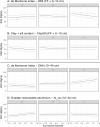Climatic water availability modifies tree functional diversity effects on soil organic carbon storage in European forests
- PMID: 37363183
- PMCID: PMC10212220
- DOI: 10.1007/s10342-023-01579-4
Climatic water availability modifies tree functional diversity effects on soil organic carbon storage in European forests
Abstract
Forest stand and environmental factors influence soil organic carbon (SOC) storage, but little is known about their relative impacts in different soil layers. Moreover, how environmental factors modulate the impact of stand factors, particularly species mixing, on SOC storage, is largely unexplored. In this study, conducted in 21 forest triplets (two monocultures of different species and their mixture on the same site) distributed in Europe, we tested the hypothesis that stand factors (functional identity and diversity) have stronger effects on topsoil (FF + 0-10 cm) C storage than environmental factors (climatic water availability, clay + silt content, oxalate-extractable Al-Alox) but that the opposite occurs in the subsoil (10-40 cm). We also tested the hypothesis that functional diversity improves SOC storage under high climatic water availability, clay + silt contents, and Alox. We characterized functional identity as the basal area proportion of broadleaved species (beech and/or oak), and functional diversity as the product of broadleaved and conifer (pine) proportions. The results show that functional identity was the main driver of topsoil C storage, while climatic water availability had the largest control on subsoil C storage. Functional diversity decreased topsoil C storage under increasing climatic water availability, but the opposite was observed in the subsoil. Functional diversity effects on topsoil C increased with increasing clay + silt content, while its effects on subsoil C were negative at increasing Alox content. This suggests that functional diversity effect on SOC storage changes along gradients in environmental factors and the direction of effects depends on soil depth.
Keywords: Context-dependency effects; Forest ecosystem services; Functional diversity; Oxalate-extractable metals; Soil organic carbon; Triplets.
© The Author(s), under exclusive licence to Springer-Verlag GmbH Germany, part of Springer Nature 2023, Springer Nature or its licensor (e.g. a society or other partner) holds exclusive rights to this article under a publishing agreement with the author(s) or other rightsholder(s); author self-archiving of the accepted manuscript version of this article is solely governed by the terms of such publishing agreement and applicable law.
Conflict of interest statement
Conflicts of interestThe authors declare no conflict of interest.
Figures



References
-
- Adhikari K, Mishra U, Owens PR, Libohova Z, Wills SA, Riley WJ, Hoffman FM, Smith DR. Importance and strength of environmental controllers of soil organic carbon changes with scale. Geoderma. 2020;375:114472. doi: 10.1016/j.geoderma.2020.114472. - DOI
-
- Al-Shammary AAG, Kouzani AZ, Kaynak A, Khoo SY, Norton M, Gates W. Soil bulk density estimation methods: a review. Pedosphere. 2018;284:581–596. doi: 10.1016/S1002-0160(18)60034-7. - DOI
-
- Ashida K, Watanabe T, Urayama S, Hartono A, Kilasara M, Mvondo Ze AD, Nakao A, Sughihara S, Funakawa S. Quantitative relationship between organic carbon and geochemical properties in tropical surface and subsurface soils. Biogeochemistry. 2021;155:77–95. doi: 10.1007/s10533-021-00813-8. - DOI
LinkOut - more resources
Full Text Sources
Other Literature Sources
